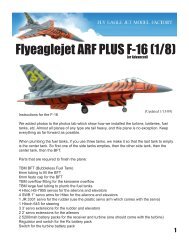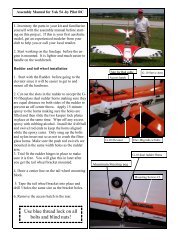Tbm dv8r manual - Troy Built Models
Tbm dv8r manual - Troy Built Models
Tbm dv8r manual - Troy Built Models
Create successful ePaper yourself
Turn your PDF publications into a flip-book with our unique Google optimized e-Paper software.
it is an ARF. The DV8R is THE premier jet for grass runways. It combines high performance with low<br />
wing loading for easy take offs from any surface, and easy landings. Being wood and covering rather<br />
than fiberglass, if you do have a mishap, repairs are quick and easy.<br />
Experience Level<br />
Building the TBM DV8R requires only basic experience with typical ARF models and turbine<br />
engines. Construction is very straightforward. It should take 20-30 hours to complete, most of which is<br />
installing the servos, hinges and retracts. Flying the DV8R is simple enough that it can be used as a<br />
turbine trainer. The wing is large with limited sweep for very stable slow flight characteristics,<br />
however, if you put a very large turbine in the plane it will have outstanding performance, as good as<br />
planes costing much more money.<br />
Options<br />
The DV8R as shipped to you is a traditional ARF. In addition to the kit there are items you will need<br />
to obtain to finish your model. Options such as landing gear, brakes, fuel tanks, servo mounts and<br />
more can be purchased directly from TBM. In many of the instructions and photos that follow some of<br />
these items are mentioned or referred to during the construction process. Please feel free to contact<br />
us for more information concerning these items.<br />
What Is Needed To Start<br />
As we mentioned earlier, it is expected that the builder of this model posses at least most of the<br />
skills necessary to construct a model of this type. With these skills comes knowledge of modeling<br />
tools that may be needed for a given procedure. For this reason we will not give a piece by piece<br />
count of every tool used during the construction of this model, rather from time to time we will mention<br />
the method and tools used to achieve a desired result on the factory prototypes. Our first model was<br />
built using very basic modeling tools, on an average size banquet table.<br />
IMPORTANT: Radio Selection – Channels and servo extension options<br />
If you use a separate channel for each servo/function you need 12 channels: 2-ailerons, 2-flaps, 2elevators,<br />
2-rudder, throttle, brakes, nosewheel steering, and retracts.<br />
You can eliminate the need for some of the 12 channels if you use (up to) 5 Y-harnesses, though you<br />
will need to program some of the servos to work properly because of end point adjustments and the<br />
need to reverse servos. There are options for reversing servos such as a servo programmer (the<br />
Hitec programmer only works with Hitec digital servos, not analog TBM part# HSprogrammer20),<br />
reversing Y (TBM part# expyrev), a JR Matchbox (TBM part# JRmatchbox), or a Smart-Fly<br />
powerexpander (various part numbers from TBM. Be sure to get one which has the programmer).<br />
1) nosewheel steering, 2 rudders (use 2 Y-harnesses). If you use 2 channels for the<br />
rudders, two 48” extensions are required. If you use a 12” Y-harness, two 36”<br />
extensions are required. The Y-harness must plug into the receiver, not into the<br />
rudders.<br />
2) ailerons<br />
3) flaps<br />
4) elevators<br />
About Adhesives<br />
The prototypes were built using a variety of adhesives throughout the process. Predominantly<br />
speaking, a good CA and Hysol are needed.<br />
2









